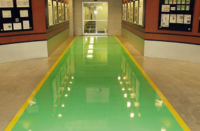The construction of Vancouver’s Olympic and Paralympic Village for the 2010 Winter Olympic Games involved all of Lafarge’s expertise in LEED certification, which was required by the specifications to reduce the buildings’ environmental footprint in terms of energy efficiency, water consumption, heating, use of local materials and reuse of any surplus. These sustainable design specifications required that the concrete have an 80 percent recycled content value. Several formulations of highvolume fly ash concrete made a strong contribution to meeting these cost, performance and sustainability requirements. Derived from burning coal in electric utility plants, fly ash can be used as a supplementary cementitious material for improving strength, durability, workability and other properties of concrete. Also, using fly ash is good for the environment, as it saves virgin raw materials, makes use of an industrial byproduct that might otherwise be disposed of in landfills, and allows concrete producers to reduce their use of portland cement. With eight complexes distributed over a 90-acre former industrial waterfront property, the impressive 600,000-square-foot village containing more than 600 dwelling units is the first phase in an immense project to redevelop the Southeast False Creek area near downtown Vancouver. ? www.lafarge-na.com
This website uses cookies so that we can provide you with the best user experience possible. Cookie information is stored in your browser and performs functions such as recognizing you when you return to our website and helping our team to understand which sections of the website you find most interesting and useful.













